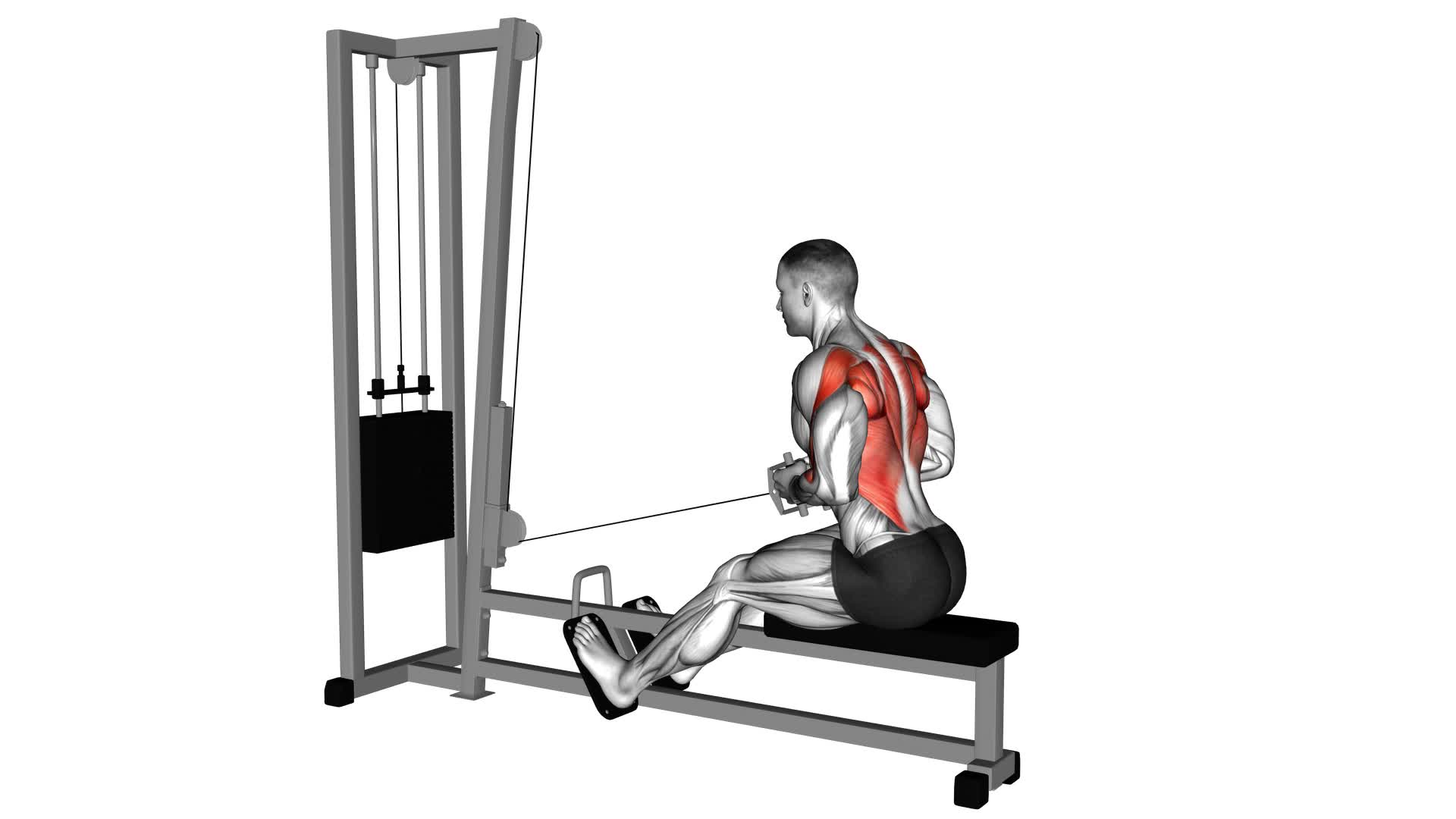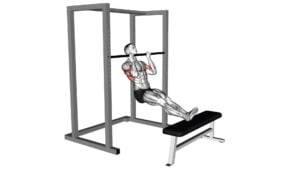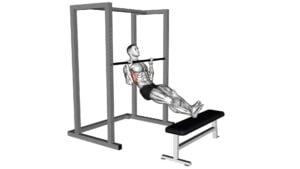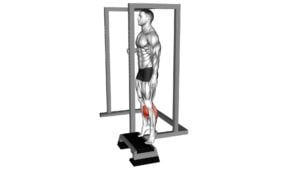Cable Elevated Row – Video Exercise Guide & Tips

Are you looking for a new exercise to target your back muscles? Look no further than the cable elevated row!
Watch This Exercise Video
In this exercise, you'll use a cable machine to perform rows while elevated off the ground. This effective move helps strengthen your upper back, shoulders, and arms.
Plus, we've got a video exercise guide and tips to ensure you're doing it correctly.
Get ready to take your back workout to the next level!
Key Takeaways
- Cable elevated row is a beneficial exercise for increasing upper body strength and muscle definition.
- Proper form and technique, such as keeping the back straight and engaging the correct muscles, are essential for maximizing exercise benefits and avoiding injury.
- Variations and progressions, such as single-arm and wide-grip cable rows, can target specific muscles and increase the intensity of the exercise.
- Avoiding common mistakes, such as using too much weight and compromising form, will help maintain proper alignment and muscle activation.
Benefits of Cable Elevated Row
You can experience increased upper body strength and muscle definition by incorporating cable elevated rows into your workout routine. This exercise specifically targets the muscles in your back, shoulders, and arms, helping to activate and strengthen them. The cable elevated row is a compound exercise, meaning it works multiple muscle groups simultaneously, making it an efficient choice for your upper body workout.
One of the main benefits of cable elevated rows is the muscle activation they provide. As you pull the cables towards your body, your back muscles, such as the latissimus dorsi and rhomboids, engage to perform the movement. Additionally, your shoulders and arms, including the deltoids, biceps, and forearms, also contribute to the exercise. This comprehensive muscle activation leads to improved strength and muscle definition in these areas.
Another advantage of cable elevated rows is their positive impact on posture. The exercise targets the muscles responsible for pulling your shoulders back and down, helping to counteract the effects of poor posture. By incorporating cable elevated rows into your routine, you can strengthen these muscles, leading to improved posture over time.
Proper Form and Technique
To perform the cable elevated row exercise with proper form and technique, focus on maintaining a strong and stable posture throughout the movement. This will ensure that you engage the correct muscles and maximize the benefits of the exercise. Here are some important tips to keep in mind:
- Keep your back straight and chest lifted.
- Squeeze your shoulder blades together as you pull the cable towards your torso.
- Avoid using momentum or jerking motions, and instead, focus on controlled movements.
- Keep your wrists straight and aligned with your forearms to avoid strain or injury.
One common misconception about the cable elevated row is that it only targets the back muscles. While it's true that the primary muscles worked during this exercise are the rhomboids, trapezius, and latissimus dorsi, it also engages other important muscles such as the biceps, forearms, and core muscles for stability.
By following these proper form and technique guidelines, you can effectively target and strengthen the muscles involved in the cable elevated row exercise.
Now, let's move on to the next section to explore variations and progressions that can help you further challenge yourself and continue to progress in your fitness journey.
Variations and Progressions
To further challenge yourself and continue progressing in your fitness journey, explore different variations and progressions of the cable elevated row exercise. By incorporating advanced variations into your routine, you can target different muscle groups and increase muscle activation.
One advanced variation of the cable elevated row is the single-arm cable row. Instead of using both arms simultaneously, this variation focuses on one arm at a time, allowing for greater control and targeting specific muscles.
Another variation is the wide-grip cable row, where you use a wider grip on the cable handle. This variation targets the upper back and shoulders more intensely.
For those looking to increase the difficulty even further, you can try the one-arm wide-grip cable row. This variation combines the benefits of both the single-arm and wide-grip cable row, providing a challenging exercise for your upper body.
It's important to remember that when performing advanced variations, proper form and technique are crucial to avoid injury. Start with lighter weights and gradually increase the resistance as your strength improves. Always listen to your body and adjust accordingly.
Incorporating advanced variations of the cable elevated row can help you continue making progress in your fitness journey. By targeting different muscle groups and increasing muscle activation, you can keep challenging yourself and achieve your fitness goals.
Common Mistakes to Avoid
When performing the cable elevated row exercise, it's important to be aware of common mistakes that you should avoid. By avoiding these errors, you can ensure that you're getting the most out of your workout and reducing the risk of injury. Here are some common mistakes to watch out for:
- Using too much weight: It can be tempting to go heavy, but using too much weight can compromise your form and put unnecessary strain on your back and shoulders. Start with a weight that allows you to maintain proper form throughout the exercise.
- Not engaging your core: Your core muscles play a crucial role in stabilizing your body during the cable elevated row. Failing to engage your core can lead to poor posture and ineffective muscle activation. Focus on bracing your core throughout the movement.
- Pulling with your arms instead of your back: The cable elevated row is meant to target your back muscles, specifically your lats. Avoid relying solely on your arms to pull the weight. Instead, focus on squeezing your shoulder blades together and engaging your back muscles.
- Allowing your shoulders to round forward: Rounded shoulders can lead to poor posture and increase the risk of shoulder injuries. Keep your shoulders pulled back and down throughout the exercise to maintain proper alignment.
Tips for Maximizing Results
Get the most out of your cable elevated row by incorporating these tips to maximize your results. To improve your performance, focus on maintaining proper form throughout the exercise. Keep your back straight, engage your core, and squeeze your shoulder blades together as you pull the cable towards your chest. This will ensure that you're targeting the correct muscles and getting the most benefit from each repetition.
Incorporating the cable elevated row into your workout routine can be done in a few different ways. One option is to use it as a warm-up exercise before your main back workout. This will activate your muscles and prepare them for the heavier lifts to come. Another option is to include it as part of a supersets or circuit training routine. By pairing the cable elevated row with other upper body exercises, you can create a challenging full-body workout that will increase your strength and endurance.
To further maximize your results, consider increasing the intensity of the exercise. This can be done by using a heavier weight or adding resistance bands to the cable. Additionally, you can vary the grip width to target different areas of your back. Experiment with different variations to keep your workouts interesting and continually challenge your muscles.
Frequently Asked Questions
How Many Sets and Reps Should I Do for the Cable Elevated Row Exercise?
For the cable elevated row exercise, it's important to determine how many sets and reps you should do based on your fitness level and goals.
To progress in this exercise, start with a weight that challenges you but allows you to maintain proper form. Aim for 2-3 sets of 8-12 reps, gradually increasing the weight as you get stronger.
Common mistakes to avoid include using too much momentum and not fully engaging your back muscles.
Can I Perform the Cable Elevated Row Exercise Using Dumbbells Instead of a Cable Machine?
Yes, you can perform the cable elevated row exercise using dumbbells instead of a cable machine. This is a great alternative equipment option if you don't have access to a cable machine. By using dumbbells, you can still target the same muscles and get a similar workout.
Just make sure to maintain proper form and adjust the weight accordingly. There are also variations of the exercise you can try with dumbbells for added challenge.
Is It Necessary to Use an Elevated Platform for the Cable Elevated Row Exercise?
Using an elevated platform for the cable elevated row exercise offers several benefits.
Firstly, it increases the range of motion, allowing for a deeper contraction of the back muscles.
Secondly, it helps to stabilize your body, reducing the risk of injury.
Additionally, the elevated platform targets the muscles from a different angle, adding variety to your workout routine.
However, if you don't have access to an elevated platform, there are variations of the exercise that can be performed on the floor or with a bench to accommodate different fitness levels.
What Muscles Does the Cable Elevated Row Primarily Target?
The cable elevated row is a great exercise for targeting multiple muscles in your upper body. It primarily works your back muscles, including the latissimus dorsi and rhomboids, which help with pulling movements. Additionally, it engages your biceps, forearms, and shoulders.
The benefits of the cable elevated row include improved posture, increased upper body strength, and enhanced muscle definition. There are variations of this exercise, such as using different grips or adjusting the height of the platform, to provide a different challenge and target specific muscles.
Can the Cable Elevated Row Exercise Help Improve Posture?
The cable elevated row exercise is a great way to improve your posture. By incorporating cable exercises into your workout routine, you can strengthen the muscles in your upper back and shoulders, which are crucial for maintaining good posture.
However, it's important to avoid common mistakes while performing this exercise, such as using too much weight or pulling with your arms instead of your back.
Following proper form and technique will maximize the benefits for your posture.
Conclusion
In conclusion, the cable elevated row is a highly effective exercise for targeting your back muscles and improving upper body strength. By maintaining proper form and technique, you can maximize your results and avoid common mistakes.
Additionally, incorporating variations and progressions into your routine can help challenge your muscles and prevent plateaus. Remember to always prioritize safety and consult with a fitness professional if needed.
Keep pushing yourself and enjoy the benefits of this powerful exercise.

Author
Years ago, the spark of my life’s passion ignited in my mind the moment I stepped into the local gym for the first time. The inaugural bead of perspiration, the initial endeavor, the very first surge of endorphins, and a sense of pride that washed over me post-workout marked the beginning of my deep-seated interest in strength sports, fitness, and sports nutrition. This very curiosity blossomed rapidly into a profound fascination, propelling me to earn a Master’s degree in Physical Education from the Academy of Physical Education in Krakow, followed by a Sports Manager diploma from the Jagiellonian University. My journey of growth led me to gain more specialized qualifications, such as being a certified personal trainer with a focus on sports dietetics, a lifeguard, and an instructor for wellness and corrective gymnastics. Theoretical knowledge paired seamlessly with practical experience, reinforcing my belief that the transformation of individuals under my guidance was also a reflection of my personal growth. This belief holds true even today. Each day, I strive to push the boundaries and explore new realms. These realms gently elevate me to greater heights. The unique combination of passion for my field and the continuous quest for growth fuels my drive to break new ground.







